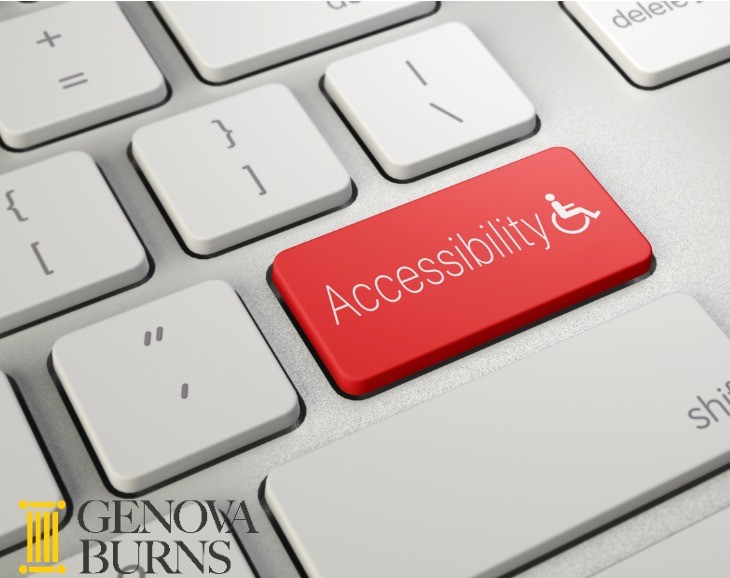New DOJ Guidance on ADA Web Accessibility Leaves Unanswered Questions
March 28, 2022 | By: Lawrence Bluestone, Esq.
On March 18, 2022, the Department of Justice (DOJ) published web accessibility guidance under the Americans with Disabilities Act (ADA). The ADA is a federal civil rights law that prohibits discrimination against people with disabilities and guarantees that people with disabilities have the same ability as everyone else to enjoy opportunities, goods, and services. Although the new Guidance establishes the DOJ’s intentions to ensure websites are accessible to all, it leaves several unanswered questions on exactly how businesses and governments are to stay in compliance with the ADA.
Circuit Split
Courts around the country have come to conflicting decisions on whether the ADA applies to website accessibility. Courts in the Ninth Circuit (covering California and most other Western states) held that Domino’s violated the ADA because its website and “app” was not fully accessible to visually impaired users. The Court found that the ADA applies where those websites and apps facilitate access to the goods and services of a place of public accommodation.
The Eleventh Circuit, by contrast, has held that websites are not subject to the ADA as understood by the plain language of the statute, dismissing a visually impaired customer’s claims against a supermarket that its website does not have compatible screen-reader software in violation of the ADA.
Federal courts in New York have landed on all sides of the debate. In conflict with other district court decisions in New York, a judge in the Eastern District of New York recently held that stand-alone websites, not connected to a physical store, are not places of public accommodation subject to the ADA. A deaf plaintiff alleged that Newsday violated the ADA by failing to include closed captioning on their website videos. The Court agreed with Newsday that stand-along websites, not connected to physical stores, are not subject to the statute.
New Guidance
With this legal uncertainty as backdrop, the DOJ recently released its Guidance on Web Accessibility and the ADA, describing how state and local governments (Title II) and businesses open to the public (Title III), can ensure that their websites are accessible to people with disabilities as required by the ADA. The DOJ writes that it has “consistently taken the position that the ADA’s requirements apply to all the goods, services, privileges, or activities offered by public accommodations, including those offered on the web.”
The ADA requires web content to be accessible from both state and local governments and public accommodation businesses. The statute requires public accommodations to provide full and equal enjoyment of their goods, services, facilities, privileges, advantages, or accommodations to people with disabilities. Public accommodations must take steps to provide appropriate communication aids and services where necessary to make sure they effectively communicate with individuals with disabilities.
The guidance lists examples of public accommodations subject to the ADA, and communication aids and services that can assist those with disabilities. Public accommodations include retail stores, banks, hotels, hospitals and medical offices, food and drink establishment, and auditoriums and sports arenas. The ADA applies to all goods, services, privileges, or activities offered by these public accommodations including those offered on their websites. Communication aids include services such as interpreters, notetakers, captions, assistive listening devices, screen readers, and voice recognition software to control computers with verbal commands.
To assist in making web content accessible to people with disabilities, the DOJ suggests businesses look at existing technical standards that the federal government uses for its own websites, such as the Web Content Accessibility Guidelines and the Section 508 Standards. Beyond this suggestion, the DOJ provides businesses with “flexibility” in how they comply with the ADA general requirements for nondiscrimination and effective communication. The DOJ does not have regulations setting out detailed standards for compliance, businesses may “choose” how they will ensure the services online are accessible to people with disabilities.
Bottom Line
The DOJ’s new guidance document leaves the legal uncertainty around ADA web-accessibility in place. Must all web-sites offering goods or services for sale comply with the ADA? Or only those connected to a brick and mortar seller? The DOJ does not appear to answer the question.
It is also unclear what “flexibility” encompasses, or what options are available for businesses to “choose” to comply with the ADA. Unlike the DOJ’s detailed ADA Standards for Accessible Design, which give detailed and specific standards for how physical spaces can be designed to comply with the ADA, the web-accessibility Guidance points to multiple and potentially contradictory sources for what companies can do to make their website sufficiently accessible for the visually or hearing impaired. With these questions unanswered, litigation around this issue will likely continue.
For more information on the ADA and web-accessibility, please contact Partner Lawrence Bluestone, Esq., who specializes in Complex Commercial Litigation by email here or call 973.533.0777.
Tags: Genova Burns LLC • Sydney Schubert • Lawrence Bluestone • ADA • DOJ • website accessibility


